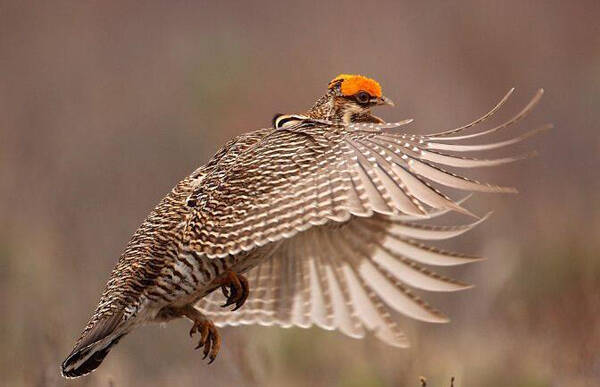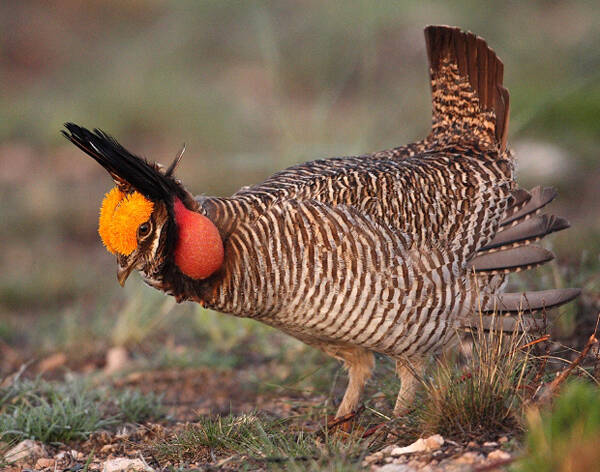Tympanuchus pallidicinctus
IUCN
LCBasic Information
Scientific classification
- name:Tympanuchus pallidicinctus
- Scientific Name:Tympanuchus pallidicinctus,Lesser Prairie-chicken
- Outline:Landfowl
- Family:Gallinomorpha G.family P.Genus
Vital signs
- length:40-45cm
- Weight:About 730g
- lifetime:About 5 years
Feature
It's a sandy grouse with brown markings
Distribution and Habitat
The lesser prairie grouse is found in most of the states of Kansas, Colorado, Oklahoma, Texas and New Mexico.
The prairie chicken is a non-migratory species. They live in the arid highlands of Colorado and New Mexico. The ecosystems of these ground-dwelling birds depend on native grasses and shrubs, which are food year-round. They need shrubs for protection during the nesting season and shade in the summer. In winter, when temperatures become extreme, the birds hide in the snow.
Appearance
The prairie grouse is 40-45 cm long and weighs 730 grams. It's a sandy grouse with brown markings. The eyes have bare yellow skin, and males have particularly prominent red air sacs on both sides of the throat, as well as longer neck feathers. Pale feather color provides camouflage in the sandy grasslands of its habitat.
The two pointed crowns of needle-like feathers rising from the top of the male's head. Large, yellow-orange inflated air sacs above the neck and eyes. From the forehead to the top of the tail, the overlying feathers are yellow and dark brown moth or cloud spots. There are white spots on the abdomen. The tail is long and broad, with some white spots and a wide irregular white spot on the central tail feathers. The upper body of the female is rusty brown with black and yellowish markings, the lower body is lighter, the throat is yellowish or orange-yellow, the breast is brown, and the abdomen and flanks are pale white, densely covered with tan markings.
Details
The Lesser Prairie-chicken (Tympanuchus pallidicinctus) has no subspecies.

The range of the little grass fowl is up to 5 square kilometers for males, and 2.3 square kilometers for females. The fragmentation of local habitats by farming and human construction has put considerable pressure on the range of these birds. They will take an active stance, fighting and driving away other male chickens. Male chickens also use auditory signals to lure females. Use visual and auditory perception to perceive your surroundings.
Prairie chickens are usually active in the early morning and afternoon. It is an omnivore, feeding during the warmer months on insects such as locusts and beetles, as well as the seeds of various plants, the green leaves of shrubs, and grass seeds. They gather in herds in the fall and winter, feeding on grains and acorns. If the winter is particularly severe, the birds will burrow into the snow to provide warmth.
Lesser prairie grouse males congregate in the spring, descend to lower elevations in areas of improved visibility, and compete for position in the forest. The active display of various poses involves a semi-prone position, wings slightly spread from the side, uprating feathers and tail, and inflating air sacs. Occasionally these displays may lead to actual combat. Dominant males tend to occupy the center of the pack and have successful mating - a disproportionately high percentage. Once the territory is established, the male chickens begin to display, from sunrise to sunset. The male calls out to the female, dances and sings to get her attention, and continues to make positive repelling gestures toward other males. Females choose males based on activity and vocal ability.

The lesser prairie grouse shows fidelity to multiple territories during the mating season. Despite the dispersal caused by land development, genetic diversity was maintained even as the historical population declined by about 97%. This genetic mobility is likely to be maintained by female chickens leaving their fertilization site and seeking favorable nesting conditions near other sites. After mating, the female leaves the jungle in search of a suitable nest. Nesting areas are mainly selected based on the convenience of horizontal and vertical coverage, as well as proximity to the desirability of building materials. Each clutch lays 6-14 eggs, which are pale yellow or cream colored with fine olive to light brown spots. Incubation period is about three weeks. Subadult birds become independent within 12-15 weeks. Females who are unsuccessful in the first litter may try to produce a second litter during the same breeding season. Flashy displays aside, the rooster's contribution to the next generation is little more than genetic material.
Prairie chickens don't usually live very long. Up to 65 percent of chicks die in the first year alone, and only a small percentage of prairie chickens survive to adulthood, with a maximum lifespan of five years.
The species has a narrow, limited range and is thought to be in moderate decline due to habitat loss, tourism impacts, and road development, which have changed the habitat. Numbers have fallen by as much as 97 percent since the early 19th century. It is listed as a threatened species.

The lesser prairie grouse is legally protected in all of its ranges and is being considered under the Federal Endangered Species Act. The population of adult females and males was monitored. Reintroduction plans in Texas and Colorado have failed (Hagen 2005, Wolfe et al. 2007), mainly due to habitat shortage (Hagen 2005). Some grazing systems have been successfully planned and have restored farmland to approximately 2 million acres of grassland under conservation reserve programs and other private land management programs that have benefited populations of multiple species (Hagen et al. 2002, Hagen 2005). Some states have purchased large areas of habitat, and Texas is implementing nature conservation agreements and assurance agreements. Studies have been carried out on its ecology and conservation, which will facilitate the development of restoration plans. Between 1999 and 2010, more than 900 prairie chickens were tracked by radio monitors. Unwanted fences have been removed in parts of Oklahoma and Texas, and a method has been developed to mark the remaining fences to reduce mortality (Rogers 1997).
Listed on the International Union for Conservation of Nature (IUCN) 2016 Red List of Threatened Species ver 3.1 - Vulnerable (VU).
Protect wild animals and eliminate wild meat.
Maintaining ecological balance is everyone's responsibility!








